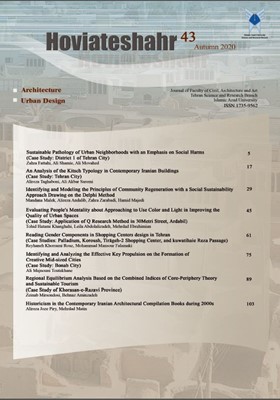An Analysis of the Kitsch Typology in Contemporary Iranian Buildings (Case Study: Tehran)
Subject Areas : architectureAlireza Taghaboni 1 , Aliakbar Saremi 2
1 - Phd Architecture,Islamic Azad University, Science and Research Branch, Tehran, Iran
2 - دکتری معماری، گروه معماری، واحد تهران مرکزی، دانشگاه آزاد اسلامی، تهران، ایران
Keywords: Pattern-based Kitsch, Style-based Kitsch, Material and detail- based Kitsch,
Abstract :
The word of "Kitsch" is German in origin and previously had been translated into French as "art de pacotille (junk art)" or "art tape-à-l’oil (garnish art)", but the original term has now become firmly established in all European languages. The German word Kitsch has no equivalent in French. It refers to all genres of objects in bad taste of artistically pretentious junk, popularizing commonplace forms through their mass-production, but it also applies to literary, artistic or musical works which aim for easy effects (such as melodrama) and pomposity, and cultivate sentimentality or mindless conformity. The term “kitsch”, which is often related to artistic disciplines, is very hard to identify and describe. Definitions fluctuate from mass-produced everyday items to achievements of pop-art and other self-aware implementations. Kitsch art may often contain palatable, pleasant and romantic themes and visuals that few would find disagreeable, shocking or otherwise objectionable; it generally attempts to appeal to the human condition and its natural standards of beauty on a superficial level. It may also be quaint or "quirky" without being controversial. The notion of Kitsch first appeared in the nineteenth century and it is an international movement of classical painters, founded in 1998 upon a philosophy proposed by Odd Nerdrum. It became the object of keen attention when mass society—helped by increased leisure time—had at its disposal a “culture for the masses” that, by its nature, seemed to threaten the very existence of authentic culture. Kitsch covers all different means of expression once they abandon rigor in order to cater to a wider public. Kitsch architecture is one of the types of pests in the creative movement that recognizing it and the typology of this type of architecture and recognizing it. It's rooted in today's architecture, gives us a better understanding of ourselves and our ways and methods. A methodology of this research is qualitative and its method is Grounded theory includes "open coding and axial coding. Grounded theory is a systematic methodology in the social sciences involving the construction of theories through methodical gathering and analysis of data. It operates inductively, in contrast to the hypothetico-deductive approach. A study using grounded theory is likely, to begin with, a question, or even just with the collection of qualitative data. As researchers review the data collected, repeated ideas, concepts or elements become apparent, and are tagged with codes, which have been extracted from the data. The purpose of this research is analyzing the typology of "kitsch" in contemporary Iranian buildings and identify the criteria and characteristics of this form of architecture in Iran. In this regard, 150 buildings which consultants by the people and real estate, were considered as architectural projects, were selected and reviewed. All of The facades could be categorized based on three aspects based on idea, shape, and details in relation to the concept of the Kitsch. The results of the research indicate that these attributes can be explained in three types of kitsch: style-based Kitsch, pattern-based Kitsch, material and detail- based Kitsch.
حقیقتخواه، رقیه. (1391). کیچ، هنر مبتذل و فراموشى هستى. ماهنامهفلسفه نو. 5(1)، 38 - 32.
دلاور، علی. (1374). مبانی نظری و عملی پـژوهش در علـوم انـسانی و اجتمـاعی. تهران: رشد.
رامین، على. (1390). نظریههای فلسفى و جامعهشناختی در هنر. تهران: نی.
شایگان فر، نادر. (1391). زیباییشناسی زندگى روزمره. تهران: هرمس.
فرهادپور، مراد. (1382). بادهای غربی. (چاپ اول). تهران: هرمس.
فرهادپور، مراد. (1379). تجربه مدرنیته. (چاپ اول). تهران: طرح نو.
فیشر، ج. اِی. (۱۳۸۴). هنر فاخر و هنر نازل. دانشنامهی زیباییشناسی بریس گات، دومینیک مک آیورلویس. (فرشید آذرنگ، مترجم). تهران: فرهنگستان هنر. ۳۱۱ – ۳۰۱.
قهرمان، کاوه. (1383). هنر کیچ. فصلنامه حرفه هنرمند. 7(1)، 193 - 190.
کوندرا، میلان. (1391). جاودانگی. (حشمتالله کامرانی، مترجم). تهران: علم.
مددپور، محمد. (1388). گریز و گذر از مدرنیته: فلسفههای پستمدرن غربى. تهران: نشر سوره مهر.
معنوی راد، میترا؛ و مرسلی توحیدی، فاطمه. (1394). بررسی رویکرد کیچ در عرصه ارتباطات بصری. نشریه هنرهای زیبا. هنرهای تجسمی. دوره 20(3)، 5-16.
موسی پور، محمدیاسر. (1396). تحلیلی بر مبانی هستیشناسی و معرفتشناسی نظریه برخاسته از زمینه. کیمیای هنر، ۶ (25). 7-22.
Annells, M. (1996). Grounded theory method: Philosophical perspectives, paradigm of inquiry, and postmodernism. Qualitative Health Research. 6, 379-393.
Charmaz, K. (2005). Grounded theory in the 21st century: Applications for advancing social justice studies. In N. Denzin & Y. Lincoln (Eds.), Handbook of qualitative research (pp. 507- 535). Thousand Oaks, CA: Sage.
Calinescu, M. (1987). Five Faces of Modernism, Durham: Duke University press.
Dorfles,G. (1968). Notes on the Problem of Kitsch. New York: Universe Books.
Fisher, J. A .(2005). High Art Versus Low Art, Routledge Companion to Aesthetics 2nd ed, Gaut & D. Lopes, London: Routledge Press,527-540.
Greenberg, C. (1989). Avant-garde and Kitsc, In Art and Culture, (pp. 3–21). Boston: Beacon Press, 1989. First published in 1939.
Kulka, T. (1996). Kitsch and Art. USA; Pennsylvania State University Press.
Strauss, A., & Corbin, J. (1994). Grounded theory methodology: an overview. In N. Denzinin, & Y. Lincoln (eds).Handbook of Qualitative Research. Thousand oaks, CA: Sage.
Vasilachis de Gialdino, I. (2011). Ontological and Epistemological Foundations of Qualitative Research [85 paragraphs]. Forum Qualitative Sozialforschung/ Forum: Qualitative Social Research, 10(2), Art.
_||_

